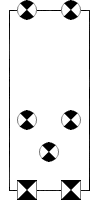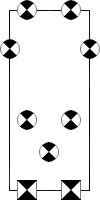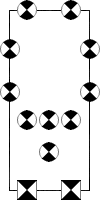 Construction of a big rig is a two stage process - designing the tractor, and then the trailer that will be attached to it, although it should be noted that trailers can be can attached to any cab and need not be kept with the cab that it is designed for.
Construction of a big rig is a two stage process - designing the tractor, and then the trailer that will be attached to it, although it should be noted that trailers can be can attached to any cab and need not be kept with the cab that it is designed for.
Like cars, there are two systems available for designing rigs in Dark Future, the basic one, which is where you just add components up to the value of the payload for the tractor, and the more advanced option from White Line Fever where the weight of all the components makes an impact on the performance of the vehicle.

The basic characteristics for tractors and rigs don't really change with the type of tractor or trailer carried. Rigs are built to haul cargo, not for speed, and as a result their speeds and handling don't really change too much if you switch trailers.
| Handling |
| Vehicle | Acceleration | Braking | Top Speed | Non HE | HE |
|---|
| Tractor | 10 mph | 20 mph | 100 mph | 2 | 8 |
| Rig | 5 mph | 6 mph | 65 mph | 2 | 10 |
The handling of the tractor rigs may seem strange but it's because trucks aren't built for handling and manoeuvring. However, their weight and size allows them to shrug off the effects of explosions that would cause smaller vehicles to lose control.
| Vehicle | Cost | Payload | Armour | Damage | Increments |
|---|
| Short Cab | $80,000 | 800 | 4 | 36 | 28/20/12/4 |
| Standard Cab | $105,000 | 1,000 | 4 | 40 | 32/24/16/8 |
| Sleeper Cab | $140,000 | 1,250 | 4 | 45 | 36/27/18/9 |
| Box Trailer | $50,000 | * | 4 | 50 | - |
| Flatbed Trailer | $30,000 | * | 2 | 30 | - |
| Tanker Trailer | $45,000 | * | 4 | 45 | - |
* Effectively a trailer has an unlimited payload. The chassis can handle thousands of pounds of weight, and the cab is the one with the engine. It's this combination that makes rigs a very dangerous opponent.
Trailers do not take incremental damage.
Payloads for the cabs may seem a bit low, but bear in mind that the engine takes up a large portion of the vehicle.
 A short cab can be found in the rear inner cover of the Dark Future rulebook, with a tanker trailer attached. Short cabs are also termed 'cabovers'.
A short cab can be found in the rear inner cover of the Dark Future rulebook, with a tanker trailer attached. Short cabs are also termed 'cabovers'.
A standard cab can be spied on page 41 of the Dark Future rulebook, with another tanker trailer attached.
A Sleeper cab can be seen on page 40 of the Dark Future rulebook, with a tanker trailer attached. The sleeper is also termed a 'longnose'.
 Box trailers are simply that, a large box mounted on wheels. They have the ability to carry large amounts of cargo, which is enclosed and fully protected by armour against gunfire and the elements. They can be refrigerated for the carrying of perishable goods. A typical box trailer can carry two cars - one in each section of the trailer - or about eight bikes, four in each section.
Box trailers are simply that, a large box mounted on wheels. They have the ability to carry large amounts of cargo, which is enclosed and fully protected by armour against gunfire and the elements. They can be refrigerated for the carrying of perishable goods. A typical box trailer can carry two cars - one in each section of the trailer - or about eight bikes, four in each section.
Flatbed trailers are effectively just a set of wheels with a board on top. They can carry as much cargo as can be crammed on top of them, which can be a lot more than can be fitted in a box trailer. All this cargo is exposed to gunfire and the elements, and a flatbeds ability to carry weapons is severely limited. They are ideal for carry jetcopters though, and can carry one of any size.
The tanker trailer is the final type of trailer that is commonly encountered. These are built to transport liquids - water and fuel are the most common - and come complete with pumps and other equipment for getting the liquid in and out of the trailer. They are limited in the weapons they can carry, which is a shame as they are usually the most prized of targets for bandits.
 Tractors and trailers can have a large amount of weapon mounts, and have the ability to mount heavy weapons on most of them too. This is another reason why they're quite deadly.
Tractors and trailers can have a large amount of weapon mounts, and have the ability to mount heavy weapons on most of them too. This is another reason why they're quite deadly.
Notes on Weapon Mounts:
 A tractor may have roof mounts or a turret, never both.
A tractor may have roof mounts or a turret, never both.
A tractor also does not have rear firing weapon mounts, but may mount weapons that fire backwards on the side or roof mounts.
Front, roof or back weapon mounts may carry heavy weapons.
|
Short Tractor

Front, two roof or turret
two passive mounts
|
Standard Tractor

Front, forward wing, two roof
or turret
two passive mounts
|
Sleeper Tractor

Front, forward wing, sides,
three roof or turret
two passive mounts
|
|
Flatbed Trailer

Two passive mounts
|
Tanker Trailer

Two turrets
two passive mounts
|
Box Trailer

Forward sides, rear sides, rear, two turrets
two passive mounts
|
 Tractor cabs generally have an occupancy of 3 - driver and two passengers. There is also space for cargo. Trailers don't have an occupancy, they are so large that you could cram as many as 40 or more passengers in (with seating).
Tractor cabs generally have an occupancy of 3 - driver and two passengers. There is also space for cargo. Trailers don't have an occupancy, they are so large that you could cram as many as 40 or more passengers in (with seating).
 While these rules only really apply to tractors, trailers can also be constructed as per these rules. They don't need to add all the special equipment, and neither do they have engines and performance charts, but they do need armour and weapons.
While these rules only really apply to tractors, trailers can also be constructed as per these rules. They don't need to add all the special equipment, and neither do they have engines and performance charts, but they do need armour and weapons.
Tractors are designed to carry additional crew other than the driver, and may seat a total of four people (including any cupola gunners).
| Carbon Steel | Carbon Plastic |
| Vehicle | Cost | Weight | Cost | Weight | Stripped Weight |
|---|
| Short Cab | $80,000 | 3,500 | $100,000 | 2,800 | 2,100 |
| Standard Cab | $105,000 | 3,800 | $140,000 | 3,000 | 2,300 |
| Sleeper Cab | $140,000 | 4,200 | $190,000 | 3,200 | 2,500 |
| Box Trailer | $50,000 | 4,000 | $75,000 | 3,000 | 1,500 |
| Flatbed Trailer | $30,000 | 2,000 | $50,000 | 1,500 | 1,000 |
| Tanker Trailer | $45,000 | 4,000 | $65,000 | 3,000 | 1,500 |
Factory stripped models are the same cost as basic carbon steel models, but retro stripping costs $10,000 for cabs and trailers.
| Carbon Steel | Carbon Plastic |
| Vehicle | Cost | Weight | Cost | Weight |
|---|
|
| $3,500 | 50 | $8,000 | 35 |
| $3,500 | 50 | $8,000 | 35 |
| $3,500 | 50 | $8,000 | 35 |
| $2,000 | 50 | $5,000 | 35 |
| $1,500 | 35 | $4,000 | 20 |
|
| $5,000 | 75 | $12,000 | 50 |
| $5,000 | 75 | $12,000 | 50 |
| $5,000 | 75 | $12,000 | 50 |
| $4,000 | 75 | $10,000 | 50 |
| $3,500 | 60 | $8,000 | 40 |
|
| $2,000 | 30 | $5,000 | 20 |
| $2,000 | 30 | $5,000 | 20 |
| $2,000 | 30 | $5,000 | 20 |
| $4,000 | 75 | $10,000 | 50 |
| NA | NA | NA | NA |
Flatbed trailers don't use roof armour.
Trailers have 10 armour locations - front, front section (each side, floor, roof), rear section (each side, floor, roof) and rear.
Flatbed trailers have 8 armour locations - they don't have a roof.
 Most special equipment that is available for cars can be carried on trucks, just at an increased cost and weight. The following details any changes.
Most special equipment that is available for cars can be carried on trucks, just at an increased cost and weight. The following details any changes.
Nox, drag chutes and rocket boosters are not usable on trucks.
 Chargers:
Chargers:
This costs $8,000. It gives a +2 mph acceleration and +8 mph maximum speed bonus.
 Active Suspension:
Active Suspension:
For $15,000 and 60 weight, active suspension will improve a trucks handling by +1.
 Robotic Drive:
Robotic Drive:
Available as either an upgrade or as a complete system, robotic drive gives a handling bonus of +2. This is instead of the bonus from Active Suspension.
| Cost | Weight |
|---|
| Complete System | $20,000 | 90 |
| Upgrade | $15,000 | 30 |
 Enhanced Computer Braking:
Enhanced Computer Braking:
This costs $10,000 and gives a +4 mph braking bonus, as well as a +10 mph panic-braking bonus.
 Reinforced Tyres:
Reinforced Tyres:
Truck tyres as standard, act like normal reinforced tyres, to account for their greater mass and toughness. However, truck tyres themselves can be reinforced. This costs $40,000 for a tractor or $32,000 for a trailer. When a reinforced truck tyre gets hit, the saving throw is now 1-5 on a 1d6. These make truck tyres very tough to damage.
 Safety Devices:
Safety Devices:
Crash suppression, ejector seats and passenger cages function as normal. They must be bought per individual who is to be protected by them.
 The backup power generator is a small engine situated in the trailer. Its aim is not to provide long term power for trailer systems, but to give a limited backup power source if the trailer is detached from the tractor, or if the tractor gets damaged and can no longer supply power to the tractor. It will automatically come online if the tractor gets an engine disabled critical hit, or if either the tractor or trailer recieves a trailer power connections critical hit. The turn after the hit occurs, the generator will have sprung into life and it will supply power to the trailer. This will be enough to power weapons, turrets, guidance systems and keep any cargo safe.
The backup power generator is a small engine situated in the trailer. Its aim is not to provide long term power for trailer systems, but to give a limited backup power source if the trailer is detached from the tractor, or if the tractor gets damaged and can no longer supply power to the tractor. It will automatically come online if the tractor gets an engine disabled critical hit, or if either the tractor or trailer recieves a trailer power connections critical hit. The turn after the hit occurs, the generator will have sprung into life and it will supply power to the trailer. This will be enough to power weapons, turrets, guidance systems and keep any cargo safe.
The generator cannot supply power to the tractor.
A backup power generator costs $15,000 and weighs 200.
 Rigs are not noted for stopping while in the badlands, and they do come across obstacles that escort vehicles cannot blow up. The way to deal with these obstacles is to usually crash right through them. While a truck is pretty tough on its own, some mount heavy ramplates on their fronts to assist them.
Rigs are not noted for stopping while in the badlands, and they do come across obstacles that escort vehicles cannot blow up. The way to deal with these obstacles is to usually crash right through them. While a truck is pretty tough on its own, some mount heavy ramplates on their fronts to assist them.
A ramplate is not just an additional armour layer on the front of the vehicle, it also includes bracing and strengthening of the rig.
A ramplate increases the speed factor of any ram or crash on the front of the rig (a head-on ram) by +2. This bonus is applied to targets of the ram, not to the damage the rig receives. In addition, the damage that the rig itself receives is reduced by 1 speed factor.
Ramplates are only mounted and effective on the front of the rig. They cost $10,000 and weigh 500. A tractor must have a minimum of 4 points of armour on the front for a ramplate to be installed.